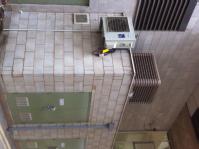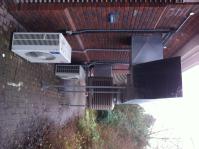Evaporative Cooling
Evaporative cooling, what is it and does it work?
An evaporative cooler is essentially a large fan with water-moistened pads in front of it. The fan draws warm outside air through the pads and blows the now-cooled air throughout the area being cooled.
Small distribution lines supply water to the top of the pads. Water soaks the pads and, thanks to gravity, trickles through them to collect in a sump at the bottom of the cooler. A small recirculating water pump sends the collected water back to the top of the pads.
Since water is continually lost through evaporation, a float valve - much like the one that controls the water in a toilet tank - adds water to the sump when the level gets low.
A large fan draws air through the pads, where evaporation drops the temperature approximately 20 degrees. The fan then blows this cooled air into the area being cooled.
Small units can be installed in a window, blowing cooled air directly into a room. Larger units can blow air into a central location, or the air can travel through ductwork to individual rooms.
Normal air conditioning is a closed system, taking air from inside a room and recycling it. For air conditioning to function properly, doors and windows should be closed. Evaporative cooling, however, takes air from outside the room. For evaporative cooling to work properly, the cooled outside air must be allowed to escape. This is generally acheived by locating extract vents at the opposite end of the room to the intake fans, this helps direct the flow of cooled air to areas where it is needed.
Compared to air-conditioning which uses mechanical refrigeration, evaporative heat exchanging operating cost are at least 90% LESS than air-conditioning.
A trial evaporative unit was installed at the university in April 2010. Since that time, the temprature in the area being cooled, has not gone above 23 degrees C and the existing mechanical air conditioning system that was installed in the room and was used to cool it down prior to the evaporative cooling system being installed, has not been used once.
More evaporative cooling units have been installed since February 2011 in key locattions on campus where mechanical air conditioning was used 24 hours a day 7 days a week. Early indications show that a 90% saving in energy is being achieved with the use of evaporative cooling technology.
The university will continue to deploy evaporative cooling units throughout buildings and areas where traditional mechanical air conditioning systems are currently being used.
A case study for the trial unit that was installed is detailed in this link: Evaporative Cooling Case Study
Areas where evaporative cooling is being used, will be closely monitored to ensure there are no adverse effects being created and that enviromental condiditons are being optimised.
Should you require any further information on this or would like to see the evaporative cooling units in operation, please contact Steve Silver at the following email address: steve dot silver at warwick dot ac dot uk



